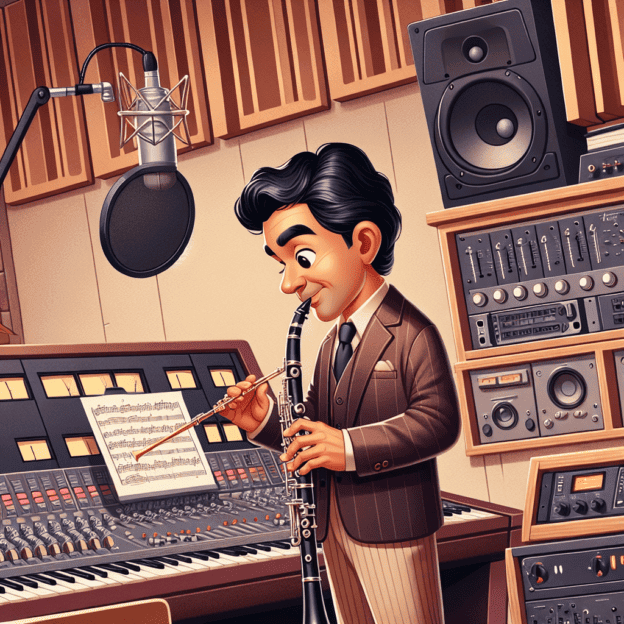Recording a clarinet can be a thrilling adventure, capturing the soul of this beautiful instrument for all to hear. Whether you're using a Martin Freres clarinet or another brand, mastering the art of clarinet sound mixing can turn your recordings from good to absolutely stunning. Let's explore some top-notch hacks for mixing clarinet sounds in recording sessions, ensuring your tones are warm, clear, and polished.
Understanding the Clarinet's Sound Profile
The clarinet has a wide range of tones, from the deep, rich chalumeau register to the bright, piercing altissimo. Balancing these registers is key to achieving a cohesive sound. Instruments like the Martin Freres clarinet are known for their consistent tone across registers, making them a favorite among recording artists. However, no matter the brand, understanding your clarinet's unique sound profile is crucial.
Choosing the Right Microphone
Microphone selection can make or break a recording session. For clarinets, condenser microphones are typically preferred due to their sensitivity and ability to capture the instrument's nuances. Place the microphone about 6-12 inches away from the clarinet's bell, angled slightly downwards to avoid direct airflow, which can cause distortion. Experiment with positioning to find the sweet spot that captures the warmth and depth of your sound.
| Microphone Type | Pros | Cons |
|---|---|---|
| Condenser | High sensitivity, captures nuances | Can be sensitive to plosives |
| Dynamic | Durable, handles high SPL | Less detailed high-end response |
| Ribbon | Warm, vintage sound | Fragile, less common |
Using Pop Filters and Windshields
Clarinet players often deal with the issue of ‘popping' sounds caused by air hitting the microphone. Using a pop filter or windshield can mitigate this issue. These tools help diffuse the air, providing a cleaner, more professional sound. This is particularly important in achieving clarity in your recordings, whether you're playing a Martin Freres clarinet or any other model.
Equalization (EQ) Tips
Equalization is where you can fine-tune your clarinet's recorded sound. Start by rolling off the low end below 80Hz to remove any rumble or unwanted noise. Boost around 200Hz to add warmth and fullness, and make slight boosts around 2kHz to 5kHz to bring out the clarinet's natural brightness. Each clarinet is unique, so these settings may vary. A Martin Freres clarinet, known for its rich tones, might need less low-end boosting compared to other brands.
Clarinet EQ Cheat Sheet
- Cut below 80Hz: Remove rumble
- Boost around 200Hz: Add warmth
- Slight boost 2kHz-5kHz: Enhance brightness
- Cut narrow bands around 1kHz-3kHz: Reduce harshness if needed
- Gentle high shelf boost above 10kHz: Add air and brilliance
Applying Compression
Compression helps to even out the dynamic range of your recording. Set a gentle ratio, such as 2:1, to smooth out the peaks without losing the instrument's natural dynamics. Be cautious with the attack and release settings; too fast an attack can dull the clarinet's transient sounds, while too slow a release can make the compression sound unnatural. Finding the right balance is crucial to maintaining the expressive qualities of your playing.
Reverb and Space
Adding reverb can give your clarinet recordings a sense of space and depth. Use a plate or hall reverb setting to emulate the sound of a concert hall. Adjust the reverb time and mix to ensure it complements the recording without overwhelming it. Remember, less is often more when it comes to reverb; you want to enhance the sound, not drown it.
Layering and Doubling
To create a fuller sound, consider layering your clarinet tracks. Record multiple takes and pan them left and right to create a stereo effect. This technique can add richness and complexity to your recordings, making them sound more professional. Doubling parts can also help in creating a thicker texture, particularly useful in ensemble pieces or when aiming for a lush, orchestral sound.
Dealing with Breath Sounds
Breath sounds are a natural part of clarinet playing but can be distracting in a recording. Use a noise gate to minimize these sounds. Set the threshold so that it cuts off the breath noise without affecting the musical tone. Alternatively, manual editing can be used to remove or reduce the volume of breath sounds. This attention to detail can significantly enhance the clarity and professionalism of your recordings.
Monitor and Adjust
Always monitor your recordings with high-quality headphones or studio monitors. This allows you to hear the subtle details and make necessary adjustments. Pay attention to how the clarinet sits in the mix with other instruments. Adjust levels, EQ, and other effects to ensure that the clarinet stands out without overpowering the other elements.
Final Touches
Once you have mixed your clarinet recording, take a step back and listen to the entire piece. Make any final adjustments to balance and effects. Trust your ears and the feedback from others. Often, fresh ears can catch nuances you might have missed. Remember, the goal is to create a recording that showcases the beauty and expressiveness of the clarinet.
By honing these sound mixing techniques, you'll be able to produce recordings that truly capture the essence of your clarinet performance. Whether using a Martin Freres clarinet or another model, these hacks will help you achieve a professional and polished sound.







